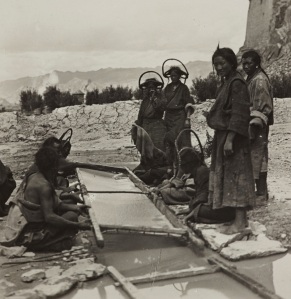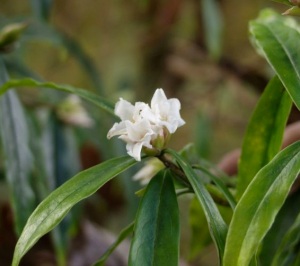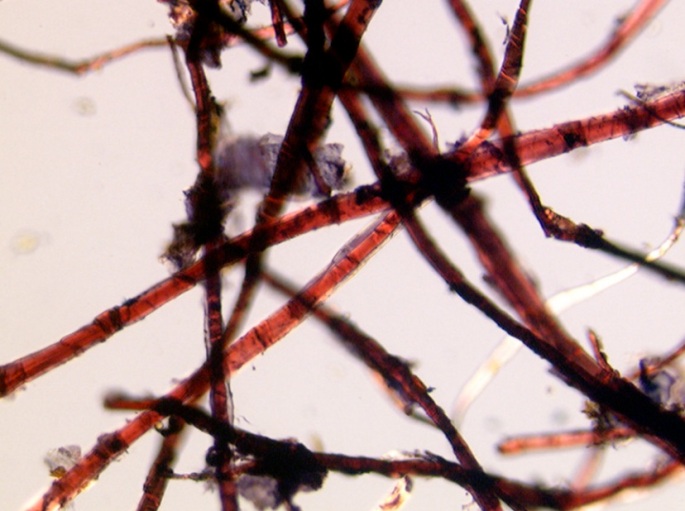What I like about working with manuscripts is that there are so many different ways to approach them. You can read the texts written on them (and sometimes that’s as far as you get) but you can also look at their shape and size, how they were put together, how the writing is laid out on the page (codicology) and the style of the writing itself (palaeography). You can get into their materiality, feel the rough and smooth sides of a page, their coarse and fine fibres, the subtle patterns of laid and chain lines. If you’re lucky, you can find out who wrote them, who owned them and how they were used, who repaired and re-used them, and so on.
I like to think this isn’t just the idle curiosity of somebody who’s spent too much time around books. While most studies of the early Tibetan manuscripts from Dunhuang and other Central Asian sites are focussed on the texts, there’s a lot more we can find out from the physicality of the thing itself. Sure, we can discover what a text is about by reading it and comparing it with other texts. But there are a lot of things we won’t know, like who made the manuscript, who used it, and what it was used for. If we can get some kind of answers to those questions about the manuscript, our understanding of the text will be enriched. Or to put it another way, if we want to know the meaning of a text, we should look at how it was used.
* * *
A few years ago I started working with Agnieszka Helman-Wazny, a scientist specializing in the study of Tibetan and Central Asian paper. Agnieszka’s speciality is the microscopic analysis of paper fibres. She also looks at the patterns left on the paper by the process of making paper (such as the fine pattern of ‘laid lines’) and other aspects of the technology of papermaking. Gradually we developed a plan to bring the results of her analysis of the paper in the Tibetan manuscripts from Central Asia with the work I had done in the palaeography of the manuscripts, and of course the contents of the texts as well. We selected a group of fifty manuscripts, put everything we could find out about them into a table, and looked at the patterns that emerged.

One of the most interesting results was this: those manuscripts that had been brought to Dunhuang from Tibet itself, were made in quite different ways from those that were made locally at Dunhuang. Though our sample was limited, this opens up the possibility of ‘fingerprinting’ a manuscript to find out where it was made.
It looks like the manuscripts made in Dunhuang and other Central Asian areas inhabited by the Tibetans during the 8th and 9th centuries were made with rag paper, which is probably mainly recycled textiles. The technical apparatus of papermaking was a mould made from a sieve made from bamboo or reeds arranged on a wooden frame, which leaves the tell-tale pattern of laid lines on the finished paper. The advantage of this kind of mould is that you can lift out the piece of paper and leave it to dry while you begin to make another one. On the other hand, in places like Tibet, Bhutan and Nepal, the method to this day is to use a wooden frame with a cloth backing stretched across it. With this kind of mould the paper cannot be removed until dry, so the paper dries on the frame. This is obviously a slower method, and the paper produced this way does not have the laid lines characteristic of the sieve method.
 Two manuscripts, letters that we already thought may have been originated from Tibet, did turn out to have been made on a woven mould. Also, they were not made of rag paper, like the locally produced Central Asian manuscripts, but paper made from the Daphne or Edgeworthia plants, which grow along the Himalayas. As well as these letters, a sutra manuscript written in the archaic ‘square style’ also turned out to be composed of Daphne fibres.
Two manuscripts, letters that we already thought may have been originated from Tibet, did turn out to have been made on a woven mould. Also, they were not made of rag paper, like the locally produced Central Asian manuscripts, but paper made from the Daphne or Edgeworthia plants, which grow along the Himalayas. As well as these letters, a sutra manuscript written in the archaic ‘square style’ also turned out to be composed of Daphne fibres.
Then there are the big Perfection of Wisdom manuscripts that were brought to Dunhuang to be used as models by the local scribes who had been ordered by the Tibetan emperor to produce copies. The Perfection of Wisdom manuscripts made in Dunhuang are composed of rag paper made on a sieve mould, like other locally made manuscripts. But those that were brought in are composed of Paper Mulberry (Broussonetia) fibres and were made on a woven mould. Paper Mulberry is not native to Central Tibet, but it is found in Eastern Tibet, so perhaps these Perfection of Wisdom manuscripts were produced in the Eastern regions of the Tibetan Empire, before being brought to Dunhuang. This would give us a triangle of geographic locations to which we can assign the manuscripts: Central Asia, Central Tibet and Eastern Tibet.
* * *
Though I can’t put the article in which we published our results on this site, I am going to make it briefly available for download here. Of course, the 50 manuscripts that we studied are a tiny proportion of the Central Asian manuscripts in Tibetan, so more work needs to be done to confirm what we have suggested. As well as using these results to pin down the geographical origin of early Tibetan manuscripts we can also say a bit more about what ‘Tibetan paper’ means in this early period. If we can begin to speak of a type of paper with specifically Tibetan characteristics, it is a paper composed of Daphne or Edgeworthia (from Central Tibet) or Paper Mulberry (from Eastern Tibet), made on a woven mould — a technology that continues to the present day.
* * *
References
Helman-Wazny, Agnieszka and Sam van Schaik. 2013. “Witnesses for Tibetan Craftsmanship: Bringing Together Paper Analysis, Palaeography and Codicology in the Examination of the Earliest Tibetan Manuscripts.” Archaeometry 55.4: 707–741. DOI: 10.1111/j.1475-4754.2012.00687.x
Iwao, Kazushi (forthcoming). “On the Tibetan Śatasāhasrikā-prajñāpāramitā sūtra from Dunhuang.” In Scribes, texts, and rituals in early Tibet and Dunhuang (eds. B. Dotson, K. Iwao and T. Takeuchi). Wiesbaden: Reichert Verlag.
Photographs
1. Paper mulberry (Broussonetia sp.) fibres stained with Herzberg stain, found in IOL Tib J 1560.
2. A large-size ‘floating’ mould, constructed with a wooden frame and attached woven textile, placed in water (a stream) in Gyantse, c. 1910–1920. Photo 1112/2 (139), © The British Library
3. The flower of the Daphne plant.
4. Sheets of paper left to dry on individual moulds on the mountain slope near Tawang, Arunchal Pradesh, 1914. MSS Eur/F157 (324), © The British Library.
* * *
Final Notes
Paper made from the Daphne and Edgeworthia species is shog shing or dung lo ma in Tibetan. There is also a Tibetan paper made from the roots of both the Stellera chamaejasme species (re lcag pa in Tibetan) and, more seldom, Euphorbia fisheriana (re lcag gi rtsa ba in Tibetan). It has been suggested that re lcag pa is the “original” Tibetan paper. Though we did not find any of this paper in our study, finds from Tibet itself may help to confirm whether it was produced during the Tibetan imperial period or later. Also, it is hard not to oversimplify this complex research, and I had better clarify here (as we did in the article) that the rag paper in the Dunhuang manuscripts was also often made with the addition of Paper Mulberry and/or Hemp. Agnieszka Helman-Wazny’s continuing work on the Chinese manuscripts from Central Asia will no doubt add much more to our knowledge of Central Asian papermaking.
* * *



Fascinating!
Thanks, Sam – stunning.
Thank you so much for the opportunity to read your work. Fascinating stuff and well documented.
Is it possible that the paper itself was used as a trade item, and the text printed on the paper at a different place? Or even possible for the raw material to be transported to another location for use in paper making? It would be interesting to know if paper production occurred near the paper’s raw material source. When you say “rags” and “rag paper” you have to realize that in modern parlance (eg in quality watercolor papers) these refer to papers based on cotton rather than wood cellulose. Cotton was available in India and (today’s Pakistan). It would be interesting to know whether cotton was imported into western Tibet and the Silk Road cities. Also what about the use of flax? Linen is not only used for clothing, but can also be used for production of paper.
Also what was the weight of those papers? My guess is that they were quite heavy compared to modern paper, but that’s just a guess. I’ve never had the chance to hold in my hands an ancient pecha.
Very interesting article the subject may reveal even more intersting facts as the study goes forward.
Very well researched and laid out. Im always glad to see what has been taking place.
You write:
«On the other hand, in places like Tibet, Bhutan and Nepal, the method to this day is to use a wooden frame with a cloth backing stretched across it. With this kind of mould the paper cannot be removed until dry, so the paper dries on the frame. This is obviously a slower method, and the paper produced this way does not have the laid lines characteristic of the sieve method.»
In Bhutan the best quality traditional paper (known as (ཚར་ཤག) is made on a bamboo or cane sieve frame and has very distinct laid lines. The National Library of Bhutan has innumerable old manuscripts written on such paper.
Formerly Bhutanese paper was very highly prized in Tibet and an important trade item. Bhutanese pilgrims also used to carry paper to many parts of Tibet. Since paper was widely traded in Tibet, I’m not so sure that being able to determine the geographical origin of the paper used would necessarily be a strong indicator of the origin of a particular manuscript.
– Chris
Cheryl – thanks for you comments. I did mention in the post that what we are calling ‘rag paper’ is textile-based. This makes sense for Dunhuang and sites further east, due to the lack of wood-pulp available there. Though some of the rag paper has Paper Mulberry and/or Hemp fibres mixed in, this could be a case of recycling older paper.
As for the movement of paper — also mentioned by Chris — this is of course very likely. Paper does generally seem to be made near the sources of raw materials, but after production could have been taken to other locations before being used to produce manuscripts. Nevertheless, our small sample showed a clear correlation between paper type and the geographical origin of the manuscripts; those that we knew from textual evidence to have come from further afield were made from a different kind of paper to those produced locally. It seems that at least for Dunhuang, the local papermaking industry was productive enough that it was not necessary to import paper. Of course, as Chris points out, this would not be the case where there is no local industry, or where paper from elsewhere is considered worth importing.
Thank you also Chris for the clarification about Bhutanese paper. I wonder how old the earliest surviving Bhutanese manuscripts on laid paper are?
– Sam
Thank you very much for the very enlightening article. Very very interesting.I learned something new. If the papers were made with wood and rags, using the term”rice paper” to refer to the paper used for the ancient Tibetan manuscripts would be wrong. Right?
Thank you Sam for all these informative and fascinating posts. What about the ink in the manuscripts – you wrote about some blood in some Dunhuang manuscripts, and that usage is indeed described in various Tibetan historical accounts – but what do we know about the ink? Is there some indication about geographical variations in the composition of the ink? I’m thinking of black and red inks, primarily, but also the gold inks? would be grateful for your insights and any references. Thanks again, Amy
Norbu – yes indeed, it would be misleading to use the term ‘rice paper’ for the early Tibetan paper that we have been testing.
Amy – the ink is the other part of the story, and I hope to have the chance to work with some results of ink and pigment analysis soon. Most of the black ink in the early manuscripts seems to be based on Carbon Black or ‘lampblack’ but others may have some iron element (and perhaps blood in a few cases). Then there are the coloured inks. I may be wrong, but I think so far there hasn’t been a publication of any scientific analysis of inks in Tibetan manuscripts.
– Sam
Thank you Sam. I have been looking at the ink and the letters written on wooden slips from Tibetan tombs in Qinghai, and also inscriptions written on silks excavated from such tombs now conserved in museums. Perhaps one can interest a museum with a good laboratory or access to the appropriate scientists
to investigate the ink….I’ll try and keep you posted.
My guess is that inks will be made of the same materials they’ve been made out of by cultures around the world. Pigments that originated in the East typically were the red lead (minium), mercury (cinnabar, vermilion), ochres, lead white, gemstone colors (lapis, malachite), gold (but not silver). Check out Kremer Pigments (offices in Germany and US) which sells historic pigments to artists.
cheryl
Reblogged this on Voynich Retro .. and commented:
A model example of cooperative research. If only..